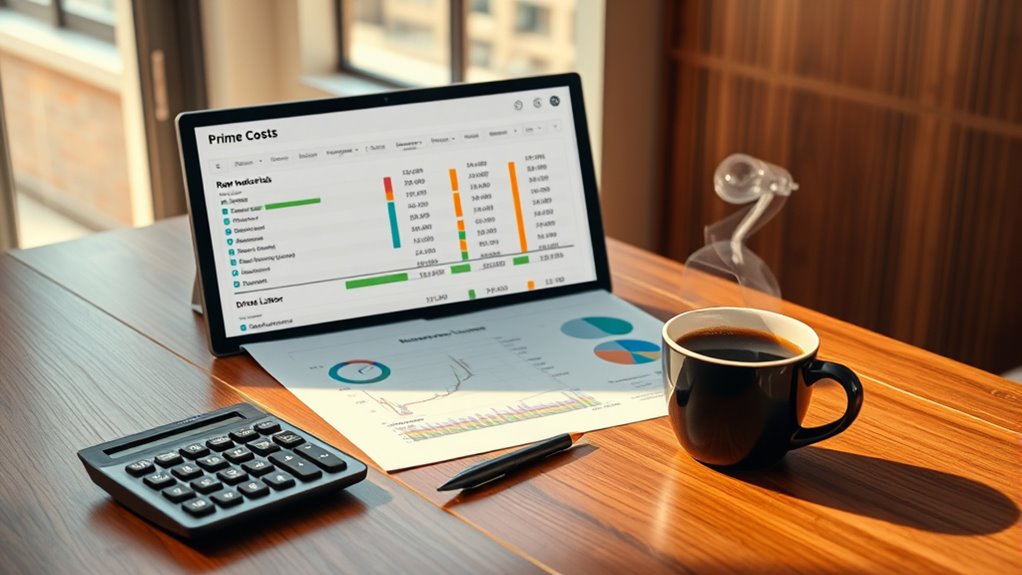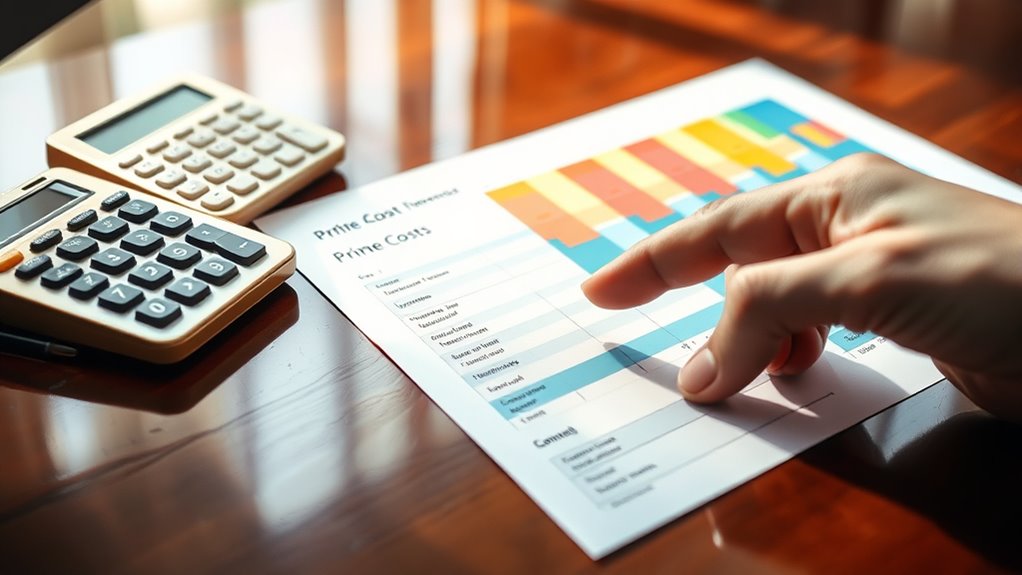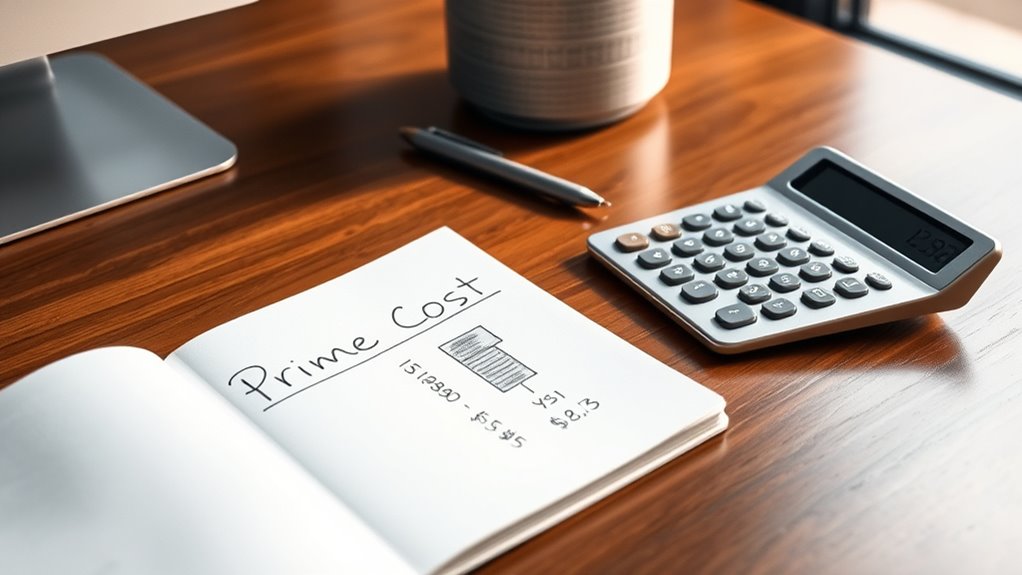Prime costs are the direct expenses you incur in production, combining raw materials like wood or fabric and wages paid to workers directly involved, such as assembly line staff. These costs are tied directly to the output and fluctuate accordingly. To calculate prime costs, add the total cost of raw materials used and direct labor costs for a specific period or job. Continuing further will help you understand how to identify, track, and apply prime cost calculations effectively.
Key Takeaways
- Prime costs consist of direct materials and direct labor costs directly involved in production.
- Calculation involves summing the costs of raw materials used and wages paid to production workers.
- Raw materials are tracked through inventory levels, purchase invoices, and usage patterns.
- Direct labor costs are determined by allocating wages and benefits based on hours worked on specific products.
- Proper differentiation from manufacturing overheads ensures accurate cost management and pricing strategies.
Understanding Prime Costs and Their Components

Have you ever wondered what goes into calculating the direct costs of producing a product? Prime costs are the key components. They include raw materials and direct labor. Raw materials are the essential inputs you need to create your product, like wood for furniture or fabric for clothing. Direct labor refers to the wages paid to workers who directly assemble or manufacture the product. These costs are directly tied to production and vary with output levels. Knowing your prime costs helps you understand the core expenses involved in making your product. It also provides insight into how efficiently you’re managing resources. By tracking these costs accurately, you can better control expenses, set appropriate pricing, and improve your overall profitability. Prime costs form the foundation of cost management in manufacturing.
The Significance of Prime Costs in Business Operations

Why are prime costs essential for running a successful business? Because they directly impact your profitability and help you make informed decisions. By understanding your prime costs, you can set accurate pricing strategies to cover expenses and achieve targeted profit margins. They also allow you to identify inefficiencies in production or service delivery, enabling you to control costs better. Monitoring prime costs regularly helps you detect cost fluctuations early, so you can adjust operations accordingly. This insight supports budgeting, forecasting, and financial planning, ensuring your business remains financially healthy. Without a clear grasp of prime costs, you risk underpricing or overspending, which can threaten your business’s sustainability. Additionally, awareness of regional divorce statistics can inform business decisions in areas with high economic mobility. Ultimately, prime costs are a crucial tool for maintaining control and driving growth in your operations.
How to Identify Raw Materials and Direct Labor Expenses

To identify raw materials and direct labor expenses, you need to recognize key indicators like inventory levels and usage patterns. Understanding the components of direct labor, such as wages and benefits, helps you track costs accurately. Using proper cost recording methods guarantees you capture these expenses effectively for precise prime cost calculation. Additionally, understanding cost components is essential for accurate financial analysis.
Raw Material Indicators
Identifying raw materials and direct labor expenses begins with examining specific indicators that distinguish them from other costs. Raw materials are typically tangible, directly involved in producing the final product, and easily traceable to the item. Look for costs that vary with production volume, such as raw ingredients or components. Direct labor expenses involve wages paid to workers directly involved in manufacturing, identifiable through time-tracking records or job codes. To clarify, here’s a quick overview: Vetted – Mother Baby Kids | Indicator | Raw Material | Direct Labor | |————————–|———————————-|———————————-| | Tangibility | Physical items used in production | Workers’ time spent on production | | Traceability | Easily traced to products | Directly linked to specific jobs | | Cost Behavior | Varies with output | Varies with labor hours | | Documentation | Purchase invoices, inventory sheets | Timesheets, payroll records
Direct Labor Components
Understanding the components of direct labor expenses is essential for accurately tracing costs to production. You need to identify wages paid to workers directly involved in making products, such as assembly line staff or machine operators. These are the labor costs that can be directly linked to specific units of output. Include wages, benefits, and payroll taxes for employees who work exclusively on production tasks. Do not count wages of supervisory or maintenance staff unless their work is directly tied to manufacturing specific items. Tracking these expenses helps you determine the true labor cost per unit. By clearly distinguishing direct labor from indirect costs, you ensure precise cost calculations, which support effective pricing, budgeting, and cost control efforts. Incorporating sound healing science principles can also provide a relaxing environment that may positively influence worker productivity and well-being.
Cost Recording Methods
How do you accurately record raw materials and direct labor expenses in your accounting system? Properly tracking these costs is essential for calculating prime costs. Use clear methods to identify and allocate expenses. For raw materials, record purchases immediately and assign costs to specific jobs or inventory. For direct labor, track hours worked on each product and multiply by the hourly rate. To simplify, consider this table:
| Expense Type | Recording Method |
|---|---|
| Raw Materials | Purchase logs, inventory tracking |
| Direct Labor | Time sheets, job cost sheets |
| Raw Materials | Assign costs per unit or job |
| Direct Labor | Allocate wages based on hours worked per job |
| Monitoring | Regular reviews to ensure accuracy |
Using consistent methods helps prevent errors and ensures precise prime cost calculations. Additionally, implementing cost recording systems can further improve accuracy and efficiency.
Step-by-Step Guide to Calculating Prime Costs

To calculate prime costs accurately, you need to identify your direct materials and compute your direct labor expenses. This involves gathering all costs related to raw materials used in production and tracking the wages of workers directly involved. Once you have these figures, you can follow the steps to determine your total prime costs. Understanding relationship dynamics can also help in managing team productivity and morale during production processes.
Identifying Direct Materials
Have you ever wondered how businesses determine the cost of raw materials used in production? To identify direct materials, start by listing all raw materials directly involved in making your product. Focus on items that become part of the finished product and can be traced easily to each unit produced. Check inventory records for materials on hand, and review purchase orders and receipts to verify costs. Remove any supplies or materials used indirectly, like tools or maintenance items. Always consider wastage, scrap, or defective materials that impact the actual material costs. Accurate identification ensures you assign the correct costs to your products, which is essential for calculating prime costs and understanding your overall production expenses. Incorporating natural materials can also improve the authenticity and appeal of your product.
Calculating Direct Labor
After identifying the direct materials involved in production, the next step is to determine the direct labor costs. First, gather your workers’ hourly wage rates. Then, track the actual hours spent on the production process for each employee or task. Multiply each employee’s hours by their wage rate to get their individual labor cost. Add these amounts together to find the total direct labor cost. If workers are paid weekly or monthly, divide their pay by the hours worked to find the hourly rate, then multiply by hours spent on production. Confirm you include only the wages directly related to manufacturing, excluding administrative or indirect labor. This calculation gives you the precise labor expense directly attributable to producing your goods, essential for accurate prime cost calculation. Additionally, understanding the importance of cost accounting helps ensure that all relevant expenses are accurately captured in your calculations.
Examples of Prime Cost Calculations in Different Industries

Ever wondered how prime costs are calculated across different industries? In manufacturing, you add direct materials and direct labor costs to find the prime cost. For example, if raw materials cost $50,000 and direct labor is $20,000, your prime cost is $70,000. In the restaurant industry, you combine ingredient costs with wages for kitchen staff. If ingredients total $10,000 and kitchen wages are $5,000, your prime cost equals $15,000. Construction projects include direct materials like lumber and direct labor hours at wages. Suppose materials cost $30,000 and labor is $15,000, then your prime cost is $45,000. These examples show how understanding prime costs helps you control expenses and improve profitability across different sectors. Additionally, in the automotive tuning industry, performance upgrades such as ECU remapping and exhaust enhancements are factored into overall project costs, demonstrating the importance of accurately calculating prime costs for comprehensive budgeting.
Differentiating Prime Costs From Other Cost Types

Understanding how prime costs differ from other cost types is essential for accurate financial analysis. Prime costs include direct materials and direct labor—expenses directly tied to production. In contrast, other costs like manufacturing overhead are indirect and not directly traceable to a specific product. Recognizing these differences helps you allocate expenses properly and assess profitability accurately. Supporting children through divorce emphasizes the importance of clear communication and stability, which can be paralleled to understanding how direct costs are identifiable and manageable within production processes.
Using Prime Cost Data to Make Informed Business Decisions

How can prime cost data guide your business decisions? By analyzing your prime costs—direct materials and labor—you gain clear insights into your cost structure. If your prime costs increase unexpectedly, it signals the need to review supplier prices or labor efficiency. Conversely, decreasing prime costs can highlight successful cost-saving measures. You can compare actual prime costs against industry benchmarks or historical data to identify areas for improvement. Using this data, you can adjust pricing strategies, control expenses, or optimize operations. Prime cost data also helps forecast profitability and set realistic budgets. Making informed decisions based on accurate prime cost analysis guarantees you allocate resources effectively, maintain competitiveness, and improve your overall financial health.
Frequently Asked Questions
How Often Should Prime Costs Be Reviewed and Updated?
You should review and update your prime costs regularly to keep your financials accurate and relevant. Typically, doing this monthly or quarterly works best, especially if your business experiences fluctuating expenses or sales. Regular reviews help you identify cost changes early, adjust pricing strategies, and maintain profitability. Don’t wait too long; frequent updates guarantee your budget and financial planning stay aligned with your current operations.
Can Prime Costs Be Applied to Service-Based Businesses?
Think of prime costs as the backbone of your service business’s financial health. Yes, you can apply prime costs to service-based businesses, as they include direct labor and materials—key components in many services. Tracking these costs helps you identify profit margins and control expenses. Regularly reviewing prime costs makes certain you stay on top of your financial game, allowing you to make informed decisions and keep your business running smoothly.
What Are Common Mistakes to Avoid When Calculating Prime Costs?
When calculating prime costs, you should watch out for common mistakes. First, avoid including indirect expenses like rent or utilities, as prime costs only cover direct materials and labor. Second, verify accurate data collection; using estimates can lead to errors. Finally, don’t forget to update your calculations regularly to reflect changes in material prices or wages. Staying precise and focused helps you get reliable prime cost figures.
How Do Fluctuations in Raw Material Prices Affect Prime Costs?
Fluctuations in raw material prices directly impact your prime costs because raw materials are a major component. When prices rise, your costs increase, reducing profit margins unless you adjust your selling prices or find cost-saving measures. Conversely, falling prices can lower your costs, but you should monitor these changes closely to stay competitive and maintain accurate cost calculations. Staying aware helps you manage budgets effectively and avoid surprises.
Are Prime Costs Relevant for Long-Term Financial Planning?
Think of your business’s financial roadmap as a sturdy bridge. Are prime costs the beams holding it steady over the long haul? Yes, they are. You need to understand and monitor prime costs because, like the foundation of a bridge, they influence your long-term financial stability. By keeping an eye on these costs, you ensure your business can withstand economic storms and cultivate a resilient future.
Conclusion
Mastering prime costs is like holding the secret weapon to business success—unlocking profits, crushing competitors, and dominating your industry! By understanding and calculating these costs accurately, you gain the superpower to make smarter decisions and skyrocket your profits. Don’t underestimate their power; ignoring prime costs is like sailing a ship blindfolded in a storm. Take control now—conquer your costs, and watch your business soar beyond your wildest dreams!









